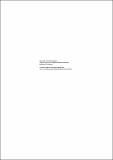| dc.contributor.author | Masakhalia, Y. F. O. | |
| dc.contributor.author | Shah, M. M. | |
| dc.contributor.author | Slater, C. S. | |
| dc.contributor.author | Walsham, G. | |
| dc.date.accessioned | 2011-04-12T14:06:17Z | |
| dc.date.available | 2011-04-12T14:06:17Z | |
| dc.date.issued | 1977-07 | |
| dc.identifier.citation | Masakhalia, Y. F. O. et al (1977) A simulation model of the Kenya national economy and its use as a guide to economic policy. Discussion Paper 246, Nairobi: Institute for Development Studies, University of Nairobi | en_GB |
| dc.identifier.uri | https://opendocs.ids.ac.uk/opendocs/handle/20.500.12413/666 | |
| dc.description.abstract | This paper describes a simulation model of the Kenya national economy.
The aim is to present a novel way of identifying, discussing and analysing a
fairly wide spectrum of development problems facing Kenya. The model consists
of a nine-sector input/output production component linked to a consumption
component composed of four rural and five urban income classes. One of the
main features of this model is that it is demand driven. Thus, growth rates
in the productive sectors are generated endogenously as a function of demand.
The model also deals with questions of income distribution, rural-urban
migration and inflation.
An overview is presented of the Kenyan economic and planning
environment and the development and applications of the Kenya Simulation Model
(KENSIM). The structure as well as the computational sequences of the model
are described. A more detailed description of the model, including the
overall structure (as reported in Slater and Walsham 1975) the set of economic
assumptions and equations, the fortran computer programme, and the details
of the data sources are reported in a forthcoming book by Slater, Walsham and
Shah(l977).
The paper goes on to discuss the application of KENSIM as a forecasting
tool and for the simulation of alternative policy options, giving the example
of rural-urban migration. The scope for further application and development
of KENSIM is wide, and some of the major areas of current interest are identified.
Some lessons and experiences are also included concerning co-operation between
decision-makers and 'model-builders', which is essential if simulation models
are to be used effectively for development planning. | en_GB |
| dc.language.iso | en | en_GB |
| dc.publisher | Institute for Development Studies, University of Nairobi | en_GB |
| dc.relation.ispartofseries | Discussion Papers;246 | |
| dc.rights.uri | http://creativecommons.org/licenses/by-nc-nd/3.0/ | en_GB |
| dc.subject | Economic Development | en_GB |
| dc.title | A simulation model of the Kenya national economy and its use as a guide to economic policy | en_GB |
| dc.type | Series paper (non-IDS) | en_GB |
| dc.rights.holder | Institute for Development Studies, University of Nairobi | en_GB |
| dc.identifier.blds | 316899 | |


